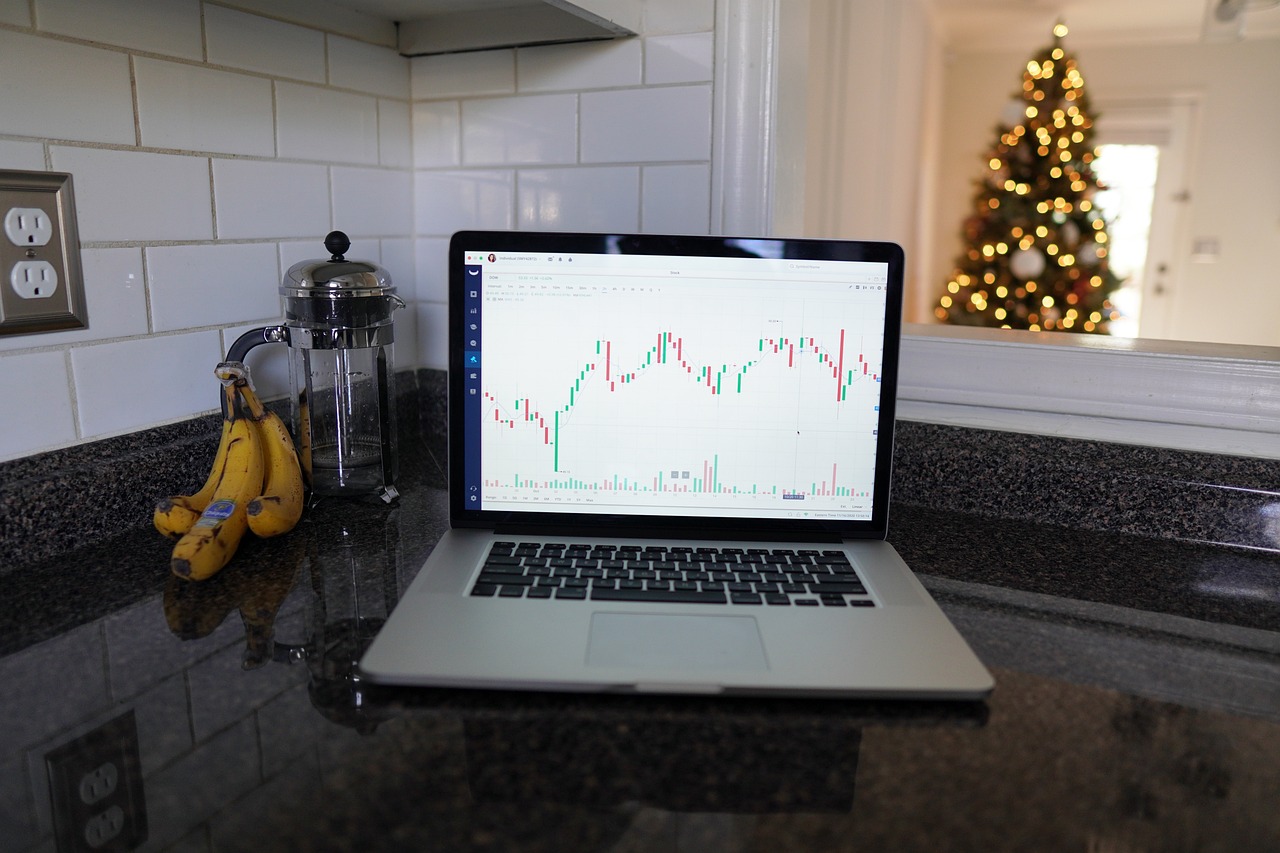The Impact of Market Trends on Exchange Operations
In today's fast-paced financial landscape, understanding the impact of market trends on exchange operations is more crucial than ever. Market trends are not just abstract concepts; they are the heartbeat of trading strategies, liquidity levels, and overall market efficiency. When traders and investors grasp these dynamics, they can navigate the complexities of the market with greater confidence. Picture this: you're at a bustling market, and the flow of people dictates how products are sold. Similarly, in the world of trading, market trends dictate how assets are bought and sold. This article delves into how these trends shape exchange operations, influencing everything from the strategies traders employ to the liquidity available in the market.
Market trends refer to the general direction in which a market is moving over a specific period. They can be upward (bullish), downward (bearish), or sideways (neutral). Recognizing these trends is akin to reading the weather before planning a picnic; it helps traders make informed decisions and adapt their strategies to optimize performance. For instance, if a trader notices a consistent upward trend, they might decide to adopt a buying strategy, whereas a downward trend may prompt them to consider selling or shorting assets. This awareness not only enhances profitability but also minimizes potential losses. In essence, understanding market trends is the cornerstone of successful trading.
Economic indicators are vital signs of a nation's economic health and significantly influence market trends. Indicators such as Gross Domestic Product (GDP), unemployment rates, and inflation rates provide traders with insights into potential shifts in exchange operations and trading behaviors. For example, a rising GDP often signals a growing economy, which can lead to bullish market trends. Conversely, high unemployment rates may indicate economic distress, prompting traders to adjust their strategies accordingly. By analyzing these indicators, traders can better anticipate market movements and make strategic decisions that align with current economic conditions.
Among various economic indicators, a few stand out for their critical role in shaping market trends:
- Inflation Rates: Rising inflation can erode purchasing power and lead to increased interest rates, which can significantly impact currency values.
- Consumer Confidence Index: This index measures how optimistic consumers feel about the economy. A high index often correlates with increased spending, which can positively influence market trends.
Inflation and interest rates are intricately linked to market trends. When inflation rises, central banks often react by increasing interest rates to control spending and stabilize prices. This reaction can lead to a stronger currency as higher interest rates attract foreign investment. However, it can also dampen economic growth, leading to potential bearish trends. Traders must stay alert to these changes, as they can drastically affect exchange operations and overall market sentiment.
The Consumer Confidence Index (CCI) is another critical economic indicator that traders should monitor. A high CCI suggests that consumers are willing to spend, which can drive economic growth and positively influence market trends. Conversely, a low CCI may indicate economic uncertainty, leading to cautious trading behaviors. By keeping an eye on the CCI, traders can gauge consumer sentiment and adjust their strategies accordingly.
Market trends directly affect trading strategies. For instance, during a bullish trend, traders might employ strategies such as momentum trading, where they buy assets that are trending upwards. On the other hand, in a bearish market, strategies like short selling become more prevalent. It's essential for traders to adapt their approaches based on current trends to maximize profits and minimize risks. Think of it like surfing; you wouldn't try to ride a wave in the opposite direction. Instead, you would align your actions with the wave's movement to stay afloat and succeed.
The rise of technological innovations has transformed trading practices, enabling faster transactions and better analysis of market trends. Understanding these advancements is vital for modern traders to remain competitive. Technologies such as algorithmic trading and blockchain are reshaping how exchanges operate, enhancing efficiency and transparency.
Algorithmic trading utilizes complex algorithms to execute trades based on market trends. This method enhances efficiency and accuracy, allowing traders to capitalize on fleeting market opportunities. By automating trading decisions, traders can react to market changes in real-time, which is crucial in today's fast-moving financial environment.
Blockchain technology is revolutionizing exchange operations by improving transparency and security. Its impact on market trends is profound, as it fosters trust among traders and investors. With blockchain, transactions are recorded in an immutable ledger, reducing the risk of fraud and ensuring that all parties have access to the same information. This level of transparency can lead to increased market participation, ultimately enhancing liquidity and market efficiency.
Anticipating future market trends is essential for effective exchange operations. By analyzing historical data and emerging patterns, traders can prepare for potential market shifts. As the financial landscape continues to evolve, staying informed about global economic shifts and sustainable investing trends will be crucial for success.
Global economic shifts, such as changes in trade policies or geopolitical events, can significantly influence market trends. For instance, a trade war between major economies can lead to increased volatility in currency markets. Staying informed about these developments is crucial for successful trading, as they can create both opportunities and risks.
Sustainable investing is gaining traction, impacting market trends and exchange operations. Investors are increasingly prioritizing environmental, social, and governance (ESG) factors in their decision-making processes. Understanding this shift can help traders align their strategies with evolving investor preferences, ensuring they remain relevant in a changing market landscape.
Q: How do market trends influence trading strategies?
A: Market trends guide traders in choosing their strategies. For instance, in a bullish market, traders might focus on buying, while in a bearish market, they may consider shorting assets.
Q: What are some key economic indicators to watch?
A: Important indicators include inflation rates, consumer confidence index, GDP, and unemployment rates. These indicators provide insights into market conditions and potential trends.
Q: How does technology impact trading?
A: Technology, such as algorithmic trading and blockchain, enhances the efficiency, speed, and transparency of trading operations, allowing traders to react swiftly to market changes.

Understanding Market Trends
Market trends are essentially the lifeblood of trading and investing. They represent the general direction in which a market is moving, whether upward, downward, or sideways. Understanding these trends is crucial for traders and investors alike, as they provide valuable insights into market behavior and help in making informed decisions. Think of market trends like the weather; just as a meteorologist studies patterns to predict rain or sunshine, traders analyze market trends to forecast potential price movements.
Recognizing market trends involves a mix of technical analysis and intuition. Traders often use various tools and indicators to identify these trends. For instance, moving averages, trend lines, and momentum indicators can help visualize the market's direction. However, it's not just about looking at charts; it’s about understanding the underlying factors that drive these trends. Economic data, geopolitical events, and even social sentiment can all play a part in shaping market dynamics.
To grasp market trends effectively, one should consider the following key aspects:
- Timeframes: Trends can occur over different timeframes—short-term, medium-term, and long-term. A trend that appears bullish on a daily chart might look bearish on a weekly chart. Understanding the timeframe is essential to align trading strategies accordingly.
- Market Sentiment: The psychology of traders can significantly influence market trends. When the majority feels optimistic, prices tend to rise; conversely, fear can lead to market declines.
- Volume: Analyzing trading volume alongside price movements can provide clues about the strength of a trend. High volume during an upward movement suggests strong buying interest, while low volume may indicate a lack of conviction.
Moreover, identifying trend reversals is equally important. Just as a calm sea can suddenly turn into a storm, market trends can shift unexpectedly. Traders must remain vigilant and adapt their strategies to avoid being caught off-guard. A trend reversal can be signaled by various indicators, including candlestick patterns, divergence in momentum indicators, or changes in volume. Recognizing these signals can provide traders with opportunities to enter or exit trades effectively.
In summary, understanding market trends is not just about observing price movements; it's about diving deep into the factors that drive those movements. By combining technical analysis with a keen awareness of external influences, traders can better navigate the complex waters of the financial markets. Remember, the key to successful trading lies in the ability to read the market’s pulse and respond accordingly.

The Role of Economic Indicators
Economic indicators are like the heartbeat of the economy; they provide essential insights into the health and direction of market trends. Think of them as the signs you see on a road trip, guiding you toward your destination. When traders and investors keep an eye on these indicators, they can make informed decisions that align with the current economic climate. Indicators such as Gross Domestic Product (GDP), unemployment rates, inflation, and consumer confidence play pivotal roles in shaping market behavior.
For instance, a rising GDP typically signals a growing economy, which can lead to increased investor confidence and higher trading volumes. Conversely, a spike in unemployment rates might indicate economic trouble, causing traders to adopt a more cautious approach. It's essential to recognize that these indicators do not operate in isolation; they often interact with one another, creating a complex web of influences that traders must navigate.
Let’s delve deeper into some of the key economic indicators that can significantly impact market trends:
- Gross Domestic Product (GDP): This is the total value of all goods and services produced in a country. A rising GDP often correlates with a robust economy, leading to increased market activity.
- Unemployment Rates: High unemployment can signal economic distress, leading to reduced consumer spending and lower market confidence.
- Inflation Rates: Inflation measures how much prices for goods and services rise over time. High inflation can erode purchasing power and influence central banks to adjust interest rates.
- Consumer Confidence Index: This index measures how optimistic consumers feel about the economy. A high index often results in increased spending, which can boost market trends positively.
Understanding these indicators allows traders to anticipate potential shifts in market dynamics. For example, if inflation is on the rise, traders might expect interest rates to follow suit. This anticipation can lead to strategic adjustments in trading positions, helping to mitigate risks and capitalize on opportunities.
In summary, economic indicators serve as crucial tools for traders looking to navigate the often turbulent waters of financial markets. By analyzing these indicators, they can gain a clearer picture of the market's trajectory and adjust their strategies accordingly. It's like having a compass in the wilderness; without it, you might find yourself lost in the fog of uncertainty.

Key Economic Indicators
When it comes to understanding market trends, serve as the compass for traders and investors alike. These indicators provide critical insights into the health of an economy, which directly influences trading behaviors and market dynamics. Among the most significant indicators are inflation rates, unemployment rates, and consumer confidence. Each of these metrics tells a different story about the economy's performance and can help traders anticipate movements in the market.
For instance, inflation rates reflect the rate at which the general level of prices for goods and services rises, eroding purchasing power. When inflation is high, central banks may increase interest rates to cool off the economy, which can subsequently affect currency values and trading strategies. On the other hand, low inflation often leads to lower interest rates, encouraging borrowing and spending, which can stimulate economic growth and positively influence market trends.
Another vital indicator is the unemployment rate. A high unemployment rate typically signals economic distress, leading to lower consumer spending and reduced market activity. Conversely, a low unemployment rate often correlates with a robust economy, where consumers are more confident and willing to spend. This increased spending can drive demand for products and services, boosting market performance.
Furthermore, the Consumer Confidence Index (CCI) is a crucial measure of how optimistic or pessimistic consumers are regarding their financial situation and the overall economy. A high CCI indicates that consumers are likely to spend more, which can lead to increased economic growth and positively impact market trends. When consumers feel confident, they are more inclined to make purchases, invest in stocks, and engage in other economic activities that drive market efficiency.
To illustrate the relationships between these indicators and market trends, consider the following table:
| Economic Indicator | Impact on Market Trends |
|---|---|
| Inflation Rate | High inflation may lead to increased interest rates, affecting currency values. |
| Unemployment Rate | High unemployment can decrease consumer spending, negatively impacting market performance. |
| Consumer Confidence Index | High confidence levels lead to increased spending and investment, boosting market activity. |
In summary, understanding these key economic indicators is essential for traders aiming to navigate the complexities of market trends. By keeping an eye on inflation, unemployment, and consumer confidence, traders can make more informed decisions, adapting their strategies to align with the economic landscape. In a world where market conditions can change in the blink of an eye, having a solid grasp of these indicators can mean the difference between profit and loss.
- What are economic indicators? Economic indicators are statistics that provide insight into the performance and health of an economy.
- Why are key economic indicators important for traders? They help traders anticipate market movements and adjust their strategies accordingly.
- How do inflation rates affect trading? Rising inflation can lead to higher interest rates, impacting currency values and trading strategies.
- What does the Consumer Confidence Index indicate? It measures how optimistic consumers are about the economy, influencing their spending behaviors.

Inflation and Interest Rates
Inflation and interest rates are two sides of the same coin, intricately linked to the ebb and flow of market trends. When inflation rises, it often leads to higher interest rates as central banks attempt to cool down an overheating economy. This relationship is crucial for traders and investors to understand, as it can significantly impact currency values and the overall dynamics of exchange operations.
To put it simply, think of inflation as the speed at which prices for goods and services rise, while interest rates are the cost of borrowing money. When inflation is high, central banks, like the Federal Reserve in the U.S., may increase interest rates to curb spending and stabilize the economy. This can lead to a stronger currency, as higher interest rates attract foreign investment, making it more appealing for investors to hold assets in that currency.
However, the relationship is not always straightforward. For instance, if inflation is perceived as temporary, traders might not react immediately to rising prices. They may choose to focus on other economic indicators or market trends. Conversely, if inflation is persistent, it could lead to a series of interest rate hikes, which can create volatility in the markets. Understanding this interplay is vital for developing effective trading strategies.
Here's a quick overview of how inflation and interest rates interact:
| Scenario | Impact on Interest Rates | Impact on Currency Value |
|---|---|---|
| Rising Inflation | Interest rates typically increase | Currency value may strengthen |
| Stable Inflation | Interest rates may remain steady | Currency value remains stable |
| Declining Inflation | Interest rates may decrease | Currency value may weaken |
In summary, the relationship between inflation and interest rates is a critical component of market trends. For traders, staying informed about inflationary pressures and central bank policies can provide a competitive edge. As they navigate through the complexities of exchange operations, understanding these economic fundamentals will help them make more informed decisions and adapt their strategies accordingly.
- What is inflation? Inflation refers to the rate at which the general level of prices for goods and services rises, eroding purchasing power.
- How do interest rates affect the economy? Higher interest rates can slow down economic growth by increasing the cost of borrowing, while lower rates can encourage spending and investment.
- Why are inflation and interest rates important for traders? Understanding these concepts helps traders anticipate market movements and make informed decisions regarding their investments.

Consumer Confidence Index
The Consumer Confidence Index (CCI) is a crucial economic indicator that reflects how optimistic or pessimistic consumers are regarding their financial situation and the overall state of the economy. When consumers feel confident, they are more likely to spend money, which can drive economic growth and influence market trends. Conversely, if confidence wanes, spending tends to decrease, which can lead to a slowdown in economic activity.
Understanding the CCI is essential for traders and investors alike. A high CCI often signals that consumers are willing to make significant purchases, which can boost company revenues and, in turn, positively impact stock prices. On the other hand, a low CCI may indicate that consumers are tightening their belts, leading to decreased sales for businesses and potentially lower stock values.
To further illustrate the relationship between consumer confidence and market trends, consider the following key aspects:
- Spending Behavior: When the CCI is high, consumers are more likely to spend on big-ticket items such as homes and cars, which can lead to increased demand for goods and services.
- Investment Decisions: Investors often look at the CCI when making decisions about where to allocate their funds. A rising CCI can lead to increased investment in stocks, while a declining CCI may prompt investors to shift their focus to safer assets.
- Market Sentiment: The CCI can also influence overall market sentiment. A strong consumer confidence report can lead to bullish market conditions, while a weak report can trigger sell-offs and increased volatility.
It's important to note that the CCI is not just a snapshot of current consumer sentiment; it also provides insights into future economic conditions. Analysts often use the CCI in conjunction with other economic indicators to forecast market trends. For example, if the CCI is rising alongside low unemployment rates and increasing GDP, it suggests a robust economy and can lead to positive market movements.
In summary, the Consumer Confidence Index serves as a barometer for the health of the economy and has a direct impact on market trends and exchange operations. Traders who keep a close eye on the CCI can better position themselves to take advantage of opportunities and mitigate risks in their trading strategies.
- What does a high Consumer Confidence Index indicate? A high CCI indicates that consumers are optimistic about the economy, which usually leads to increased spending and economic growth.
- How often is the Consumer Confidence Index updated? The CCI is typically released monthly, providing timely insights into consumer sentiment.
- Can the Consumer Confidence Index predict market trends? While it is not a definitive predictor, a rising or falling CCI can provide valuable insights into potential market movements.

Impact on Trading Strategies
Market trends wield significant influence over trading strategies, shaping how traders approach the exchange operations. In the fast-paced world of trading, where every tick can mean the difference between profit and loss, understanding trends is not just beneficial—it's essential. Traders need to be like surfers, riding the waves of market movements. If they misread the swell, they could wipe out instead of riding high. So, how exactly do these trends impact trading strategies?
First and foremost, traders must adapt their strategies based on the current market environment. For instance, during a bullish trend, where prices are rising, traders might lean towards aggressive strategies, such as buying more assets or leveraging their positions. Conversely, in a bearish market, characterized by falling prices, a more defensive approach may be warranted, including short selling or opting for safe-haven assets. This adaptability is crucial; the market is like a living organism, constantly changing and evolving.
Moreover, the impact of market trends extends to the tools and techniques traders employ. For example, technical analysis becomes increasingly relevant during trending markets. Traders often rely on chart patterns, moving averages, and momentum indicators to gauge the strength and direction of a trend. These tools help them make informed decisions about when to enter or exit trades. It's akin to using a compass in the wilderness; without it, you could easily lose your way.
In addition to technical analysis, fundamental analysis plays a vital role in shaping trading strategies. Economic indicators, as mentioned earlier, can signal shifts in market trends. Traders who keep a close eye on these indicators can anticipate changes and adjust their strategies accordingly. For instance, if consumer confidence is on the rise, it may signal an upward trend in stock prices, prompting traders to buy. On the other hand, if unemployment rates spike, it could indicate a downturn, leading traders to exercise caution.
Lastly, the psychological aspect of trading cannot be overlooked. Market trends can significantly influence trader sentiment. During a strong uptrend, optimism can lead to herd behavior, where traders jump on the bandwagon, driving prices even higher. However, in a downtrend, fear and uncertainty can cause panic selling. Understanding these psychological factors allows traders to manage their emotions and make rational decisions rather than succumbing to the market's whims.
In summary, the impact of market trends on trading strategies is profound and multifaceted. Successful traders are those who can read the signs, adapt their strategies, and remain aware of the psychological dynamics at play. By doing so, they position themselves to navigate the ever-changing landscape of exchange operations effectively.
- How do market trends affect trading decisions?
Market trends guide traders in determining when to buy or sell assets, helping them to optimize their strategies based on the prevailing market conditions. - What tools can traders use to identify market trends?
Traders often use technical analysis tools such as moving averages, trend lines, and momentum indicators to identify and analyze market trends. - Why is it important to adapt trading strategies?
Adapting trading strategies is crucial because market conditions can change rapidly, and a strategy that works in one trend may not be effective in another. - How do economic indicators influence trading strategies?
Economic indicators provide valuable insights into potential market movements, allowing traders to adjust their strategies based on anticipated changes in the market.

Technological Advancements in Trading
In today's fast-paced financial landscape, technological advancements have become the backbone of trading operations. These innovations not only streamline processes but also provide traders with tools to analyze market trends more effectively than ever before. Imagine trying to navigate a bustling city without GPS; that's akin to trading without modern technology. The ability to access information swiftly and execute trades almost instantaneously is what separates successful traders from the rest.
One of the most significant advancements has been the rise of algorithmic trading. By leveraging complex algorithms, traders can automate their trading strategies, executing trades at lightning speed based on predefined criteria. This is particularly advantageous in volatile markets where every second counts. For instance, a trader can set parameters to buy a currency pair when it reaches a certain price and sell it when it hits another, all without lifting a finger. The efficiency gained through algorithmic trading not only enhances profitability but also minimizes emotional decision-making, which can often lead to costly mistakes.
Moreover, the advent of blockchain technology is revolutionizing exchange operations. Blockchain provides a decentralized ledger that enhances transparency and security in transactions. This technology ensures that all trades are recorded in an immutable manner, fostering trust among traders and investors alike. With blockchain, the risk of fraud is significantly reduced, and the speed of transactions is greatly improved, allowing for real-time settlement. This is akin to having a bank that operates 24/7 without the usual delays associated with traditional banking systems.
As we delve deeper into these advancements, it’s essential to recognize the importance of data analytics. The ability to analyze vast amounts of data quickly allows traders to identify patterns and trends that were previously undetectable. For example, traders can utilize machine learning algorithms to predict future market movements based on historical data. This not only saves time but also enhances the accuracy of trading strategies. In a world where information is power, the ability to harness this data effectively can provide a significant edge in the market.
Furthermore, the integration of artificial intelligence (AI) into trading platforms is another game-changer. AI can process and analyze data at a scale and speed that humans simply cannot match. This technology can help traders make informed decisions by providing insights into market sentiment and potential future movements. Imagine having a personal assistant that sifts through mountains of data, pinpointing exactly what you need to know to make a successful trade. That's the power of AI in trading.
In conclusion, the impact of technological advancements in trading cannot be overstated. From algorithmic trading to blockchain and AI, these innovations are reshaping how traders operate and interact with the market. Staying updated with these technologies is no longer optional; it's a necessity for anyone serious about trading in today's digital age. As we look to the future, one thing is clear: the traders who embrace these advancements will be the ones who thrive in an ever-evolving marketplace.
- What is algorithmic trading?
Algorithmic trading involves using computer algorithms to execute trades based on predetermined criteria, enhancing speed and efficiency.
- How does blockchain technology affect trading?
Blockchain technology improves transparency and security in trading by providing a decentralized and immutable ledger for transactions.
- What role does AI play in trading?
AI analyzes vast amounts of data to provide insights, helping traders make informed decisions and predict market movements.

Algorithmic Trading
Algorithmic trading is like having a super-smart assistant in the world of finance. Imagine being able to execute trades at lightning speed, analyzing vast amounts of data in seconds, and making decisions based on complex algorithms that consider every little market nuance. This method of trading has transformed the landscape for traders, allowing them to capitalize on fleeting opportunities that would be impossible to catch manually. The beauty of algorithmic trading lies in its ability to remove the emotional aspect of trading. Traders often fall prey to fear or greed, making rash decisions that can lead to significant losses. However, algorithms operate purely on data and predefined rules, ensuring that trades are executed with precision and consistency.
At its core, algorithmic trading can be categorized into several strategies, each designed to exploit specific market conditions. Here are some common strategies:
- Trend Following: This strategy involves identifying and following the direction of market trends. Algorithms analyze past price movements to predict future trends, allowing traders to enter positions that align with the market direction.
- Arbitrage: This involves taking advantage of price discrepancies between different markets or instruments. Algorithms can quickly identify these discrepancies and execute trades to profit from them before they disappear.
- Market Making: Market makers provide liquidity to the market by placing buy and sell orders. Algorithms help in managing these orders efficiently, ensuring that the market remains liquid.
Moreover, the integration of machine learning and artificial intelligence into algorithmic trading is taking this practice to new heights. Algorithms can now learn from historical data, adapt to changing market conditions, and even predict future movements based on patterns that humans might overlook. This level of sophistication not only enhances trading performance but also contributes to overall market efficiency.
However, with great power comes great responsibility. Algorithmic trading is not without its challenges. Issues such as technical glitches, market manipulation, and the potential for flash crashes—where markets plunge suddenly due to algorithmic trading errors—are concerns that traders and regulators alike must address. Therefore, while algorithmic trading offers remarkable advantages, it also necessitates a robust risk management framework to mitigate potential pitfalls.
In summary, algorithmic trading represents a significant evolution in how trading is conducted in today’s financial markets. By leveraging technology, traders can enhance their strategies, improve execution speed, and ultimately increase their chances of success. As we move forward, understanding and embracing these technological advancements will be crucial for anyone looking to thrive in the ever-evolving world of trading.
- What is algorithmic trading? Algorithmic trading involves using computer algorithms to execute trades based on predetermined criteria, allowing for faster and more efficient trading.
- How does algorithmic trading work? It uses mathematical models and formulas to analyze market data and make trading decisions, often executing trades in milliseconds.
- Is algorithmic trading suitable for all traders? While it offers advantages, it requires a solid understanding of programming and market dynamics, making it more suitable for experienced traders.
- What are the risks associated with algorithmic trading? Risks include technical failures, market manipulation, and flash crashes, which can lead to significant financial losses.

Blockchain Technology
Blockchain technology is not just a buzzword; it's a revolutionary force that is reshaping the landscape of exchange operations. Imagine a digital ledger that is not only secure but also transparent and immutable—this is the essence of blockchain. It allows for the recording of transactions in a way that is both traceable and verifiable, which is a game-changer for traders and investors alike. By eliminating the need for intermediaries, blockchain reduces transaction costs and enhances the speed of exchanges, making it a critical component in today's fast-paced trading environment.
One of the most significant impacts of blockchain on market trends is its ability to foster trust among participants. In traditional exchanges, the reliance on third-party institutions can sometimes lead to delays and inefficiencies. However, with blockchain, every transaction is recorded in real-time, and all parties involved can access the same information simultaneously. This transparency not only builds confidence but also helps in preventing fraud, making the trading environment safer for everyone involved.
Furthermore, blockchain technology facilitates smart contracts, which are self-executing contracts with the terms of the agreement directly written into code. These contracts automatically enforce and execute terms when predetermined conditions are met. This innovation significantly reduces the time and costs associated with contract management and dispute resolution. For instance, in foreign exchange operations, smart contracts can automate the execution of trades based on specific market conditions, allowing traders to seize opportunities without the need for constant monitoring.
To illustrate the impact of blockchain on exchange operations, consider the following table that compares traditional trading methods with blockchain-enabled trading:
| Aspect | Traditional Trading | Blockchain Trading |
|---|---|---|
| Transaction Speed | Hours to Days | Seconds to Minutes |
| Intermediaries | Required | Not Required |
| Security | Moderate | High |
| Transparency | Limited | High |
As we look to the future, the integration of blockchain technology in exchange operations is likely to deepen. More traders are beginning to recognize the benefits of this technology, not just for its efficiency but also for its potential to democratize access to financial markets. The rise of decentralized finance (DeFi) platforms, which leverage blockchain to provide financial services without traditional intermediaries, is a testament to this shift. Traders who understand and utilize blockchain technology will undoubtedly have a competitive edge in the ever-evolving market landscape.
- What is blockchain technology? Blockchain technology is a decentralized digital ledger that records transactions across many computers in such a way that the registered transactions cannot be altered retroactively.
- How does blockchain improve security in trading? Blockchain enhances security by creating a tamper-proof record of transactions, making it extremely difficult for fraud to occur.
- What are smart contracts? Smart contracts are self-executing contracts with the terms of the agreement directly written into code, allowing for automatic execution when conditions are met.
- Can blockchain technology reduce trading costs? Yes, by eliminating intermediaries and automating processes, blockchain can significantly lower transaction costs.

Future Market Trends
Anticipating is not just a luxury for traders; it’s a necessity. As the financial landscape continues to evolve, understanding the shifts that lie ahead can make all the difference in successful exchange operations. Think of it like navigating a river: if you know the currents and the rocks that lie beneath the surface, you can steer your boat to safety and perhaps even find hidden treasures along the way.
One of the most significant factors influencing future market trends is the impact of global economic shifts. These shifts can arise from various sources, including changes in trade policies, geopolitical events, or even natural disasters. For instance, when a major economy like the United States implements new tariffs, it can ripple through the markets, affecting everything from currency values to commodity prices. Staying informed about these developments is crucial for traders, as it allows them to adjust their strategies proactively rather than reactively.
Moreover, the rise of sustainable investing trends is reshaping the financial markets in profound ways. Investors are increasingly prioritizing environmental, social, and governance (ESG) factors in their investment decisions. This shift is not just a passing fad; it reflects a growing awareness of the long-term impacts of corporate behavior on society and the planet. As a result, companies that align with these values may find themselves attracting more investment, while those that do not could see their market positions erode. Understanding this trend can help traders align their strategies with evolving investor preferences, tapping into a growing market segment that prioritizes sustainability.
To illustrate the impact of these trends, consider the following table that summarizes key factors and their potential effects on future market dynamics:
| Trend | Potential Impact |
|---|---|
| Global Economic Shifts | Changes in currency values, commodity prices, and trade flows. |
| Sustainable Investing | Increased capital flow into ESG-compliant companies, affecting stock performance. |
| Technological Advancements | Enhanced trading efficiency and new investment opportunities. |
As we look to the future, it’s essential to keep an eye on these trends and their implications for exchange operations. Traders who can adapt to these changes will not only survive but thrive in a competitive environment. Just like a surfer riding a wave, those who can anticipate the movements of the market will find themselves riding high, while those who remain stagnant may get swept under.
- What are market trends? Market trends refer to the general direction in which a market is moving, influenced by various factors including economic indicators and investor sentiment.
- How do economic shifts affect trading? Economic shifts can influence currency values, commodity prices, and overall market sentiment, prompting traders to adjust their strategies accordingly.
- What is sustainable investing? Sustainable investing focuses on investing in companies that prioritize environmental, social, and governance factors, reflecting a growing trend among investors.
- Why is it important to anticipate future market trends? Anticipating future market trends allows traders to make informed decisions and adjust their strategies proactively, enhancing their chances of success.

Global Economic Shifts
The world of finance is constantly evolving, and one of the most significant factors driving this evolution is . These shifts can be triggered by a variety of events, including changes in trade policies, geopolitical tensions, and economic crises. Understanding these shifts is crucial for traders and investors who want to navigate the complex landscape of modern markets successfully.
For instance, when a major economy like the United States or China alters its trade policies, it can send ripples through global markets. These changes can affect currency values, commodity prices, and overall market sentiment. Traders need to stay alert to these developments, as they can create both opportunities and risks. A sudden announcement of tariffs can lead to a spike in volatility, forcing traders to rethink their strategies on the fly.
Moreover, geopolitical events such as elections, conflicts, or international agreements can significantly influence market trends. For example, the uncertainty surrounding Brexit had profound implications for the European Union and the global economy. The shifts in trade relationships that followed prompted traders to adjust their positions, highlighting the interconnectedness of global markets.
To illustrate the impact of these shifts, consider the following table that outlines some recent global economic events and their effects on market trends:
| Event | Date | Impact on Markets |
|---|---|---|
| US-China Trade Tariffs | 2018 | Increased volatility in stock and currency markets |
| Brexit Referendum | 2016 | Sharp decline in GBP; increased uncertainty in EU markets |
| COVID-19 Pandemic | 2020 | Global market crash; surge in technology stocks |
As we move forward, it’s essential for traders to not only react to these shifts but also to anticipate them. This requires a keen understanding of both global economic indicators and the broader geopolitical landscape. By doing so, traders can position themselves advantageously, mitigating risks while seizing opportunities that arise from these dynamic changes. After all, in the fast-paced world of trading, being proactive is often the key to success.
In conclusion, global economic shifts are not just background noise; they are powerful forces that shape market trends and influence exchange operations. By staying informed and adaptable, traders can navigate these changes and potentially thrive in an ever-evolving marketplace.
- What are global economic shifts? Global economic shifts refer to significant changes in the economic landscape that can affect trade policies, currency values, and overall market trends.
- How do geopolitical events impact trading? Geopolitical events can create uncertainty, leading to increased volatility and prompting traders to adjust their strategies accordingly.
- Why is it important to understand economic indicators? Economic indicators provide insights into the health of an economy, helping traders anticipate market movements and make informed decisions.

Sustainable Investing Trends
Sustainable investing is no longer just a buzzword; it's a movement that’s reshaping the financial landscape. As more investors become aware of the impact their investments can have on the world, there’s a noticeable shift towards **environmentally friendly** and **socially responsible** investment strategies. This trend is not just about doing good; it's also about recognizing that sustainability can lead to **long-term financial performance**. In fact, many studies have shown that companies with sustainable practices often outperform their less responsible counterparts.
One of the driving forces behind sustainable investing is the growing awareness of climate change and social issues. Investors are increasingly looking for ways to align their portfolios with their values, which means they're more inclined to invest in companies that prioritize **sustainability**. This shift is evident across various sectors, including renewable energy, sustainable agriculture, and ethical technology. As a result, companies that fail to adopt sustainable practices risk losing not only their market share but also their investor base.
Moreover, the rise of **Environmental, Social, and Governance (ESG)** criteria has made it easier for investors to evaluate potential investments based on their sustainability practices. These criteria provide a framework for assessing how well a company is managing risks and opportunities related to environmental and social issues. In fact, many investment funds are now incorporating ESG factors into their decision-making process, leading to a significant increase in **sustainable investment funds**.
To illustrate the impact of sustainable investing, consider the following table, which highlights the growth of sustainable investment funds over the past few years:
| Year | Sustainable Investment Funds (in billions) |
|---|---|
| 2018 | $12 trillion |
| 2019 | $17 trillion |
| 2020 | $21 trillion |
| 2021 | $35 trillion |
This table clearly shows the **exponential growth** of sustainable investment funds, indicating a strong trend that is likely to continue. As more investors prioritize sustainability, we can expect to see an increase in the number of companies adopting sustainable practices to attract this growing pool of capital. Furthermore, this trend is not just a fleeting phase; it’s a fundamental shift in how investors view their role in the economy.
In addition to financial performance, sustainable investing also addresses the **ethical considerations** that many investors are increasingly prioritizing. For instance, they want to ensure that their money is not supporting industries that contribute to environmental degradation or social injustice. This ethical dimension adds another layer of complexity to investment decisions but also makes the process more rewarding for those who care about the world around them.
Ultimately, the shift towards sustainable investing is not just beneficial for the planet and society; it also opens up new opportunities for traders and investors. By understanding and adapting to these trends, traders can position themselves to capitalize on emerging sectors that are likely to experience significant growth. As we look to the future, it’s clear that sustainable investing will play a pivotal role in shaping market trends and exchange operations.
- What is sustainable investing? Sustainable investing focuses on investing in companies that prioritize environmental, social, and governance (ESG) criteria, aiming for both financial returns and positive societal impact.
- Why is sustainable investing important? It promotes responsible business practices, helps mitigate risks associated with climate change, and aligns investments with personal values.
- How can I start sustainable investing? You can start by researching sustainable funds, considering ESG criteria in your investment decisions, and consulting with financial advisors who specialize in sustainable investing.
Frequently Asked Questions
- What are market trends?
Market trends refer to the general direction in which a market is moving, whether it's upward, downward, or sideways. Recognizing these trends is crucial for traders as it helps them make informed decisions and tailor their strategies to optimize performance.
- How do economic indicators affect market trends?
Economic indicators, such as GDP, inflation rates, and unemployment levels, significantly influence market trends. By analyzing these indicators, traders can gain insights into potential shifts in market behavior and adjust their trading strategies accordingly.
- What is algorithmic trading?
Algorithmic trading is a method that uses complex algorithms to execute trades based on market trends. This approach enhances trading efficiency and accuracy, allowing traders to seize fleeting market opportunities effectively.
- How does blockchain technology impact exchange operations?
Blockchain technology improves transparency and security in exchange operations, fostering trust among traders and investors. Its revolutionary impact on market trends is making it an essential consideration for modern trading practices.
- What are some key economic indicators to watch?
Key economic indicators include inflation rates, consumer confidence indices, and interest rates. These indicators play a vital role in shaping market trends, and understanding them can help traders anticipate market movements.
- Why is it important to anticipate future market trends?
Anticipating future market trends is essential for effective exchange operations. By analyzing historical data and emerging patterns, traders can prepare for potential market shifts and position themselves for success.
- What is sustainable investing, and how does it affect market trends?
Sustainable investing focuses on making investments that consider environmental, social, and governance (ESG) factors. This trend is gaining traction and influencing market dynamics, prompting traders to align their strategies with evolving investor preferences.
- How can traders adapt their strategies based on market trends?
Traders can adapt their strategies by closely monitoring market trends and adjusting their approaches accordingly. This may involve changing their asset allocation, employing different trading techniques, or even shifting their focus to different markets or sectors.


















